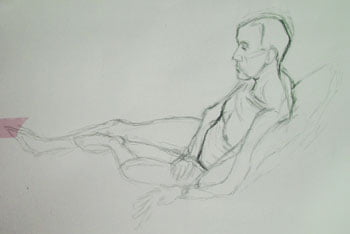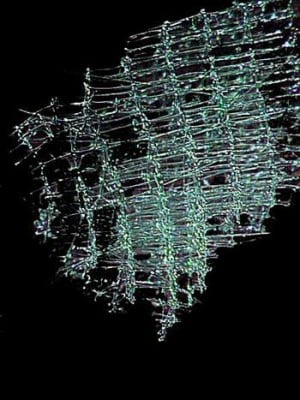silk scaffolding

This week’s life drawing class was harder for me than the last one… I wasn’t feeling zen enough – and so it was a bit of a struggle. But wherein lies the struggle? Mainly, I feel, it is in my desire for excellence… Of course, underlying this is a fear of failure… so that with each stroke, and at every stage of the drawing, I am fighting the anxiety that this is not good enough.
Why am I bothering you with this…? well, it is because this has a direct bearing on my writing. It seems to me that writing (and all creative endeavour) is a balance between ‘spontaneity’ and ‘control’… In me, the former has been very much under the shadow of the latter. (This is symbolized in the Stone Dance by a Sapient with his hands coiled around the throat of his homunculus… an image that has even deeper resonances for me than the one I’m pointing out here.) I fear free spontaneity – fear that what I am trying to do will slip through my fingers and disappear into the sand. So I hold tight to it. This explains much of the tortured cradle that I felt necessary to construct to support the building of the Stone Dance… the spirit of which has only recently sailed free… That cradle was of stones, as heavily build as a pyramid – and one of the main reasons it took me so long to write the trilogy. Now, however, I wish to find liberation from such labours… Thus, partially, the life drawing, where I am forced to confront my anxiety that what I build should at all times be visibly solid… Instead, what I am doing now is trying to learn to work with a scaffolding of delicately tensioned silk.

” life drawings has played such a central role in Western art”
Reminds me that there was this strange thing in Greek sculpture where they added an extra muscle above the hip, just because it pleased them aesthetically…
If you look at ancient Greek sculpture, you’ll see that the statues are always smiling. This wasn’t done because they were friendly people, but because (somehow) it was easier to sculpt the mouth that way.
http://kbagdanov.files.wordpress.com/2009/03/greek-art-40.jpg
Also note the position of the feet here, which is adapted from Egyptian…
Details are a bit vague – ‘t has been ages since I had art history lessons.
*grin* didn’t know about that extra muscle… though, if you look at a lot of artwork – comics in particular – extra muscles are legion… (no doubt a sign of the sad diminution in the attendance of life drawing classes *wide grin*)…
as for you photo: I recognize it as being a very early example of maturing Greek sculpture… and it is VERY Egyptian… not just the feet, but also straight forward facing shoulders and the position of the arms… consider this statue of Amenophis III…
Perhaps Stone Dance was an ice berg, with 3/4 (the scaffolding work) under water and not visible. Sure, the submerged bit keeps the thing afloat and will prevent it from melting quickly (to run with this analogue), but there is always the danger of looking at the visible part above water and thinking: “Twelve years of work – this is it???”
As life drawing is concerned – be less result-driven, and use it instead as an exercise in observing, eye-hand coordination and such… The end result should not count at all! It is funny though, that if the basic drawing, the composition, the dimensions and internal relationships of the figure, aren’t drawn right, no detailing and shading will save the picture. And it is exactly because a human being is such a well-defined balanced ‘thing’ (and we all have an instinctive knowledge of what it should look like) that we’ll see when it’s not working.
One thing you can mull over is ‘negative space’, delineating the figure by drawing the surrounding space’s shape.
yes… the iceberg analogy is one I’ve used myself… though about the Stone Dance, in that so much of what it appears to be about is really quite a small part of the whole – that much of it is hidden beneath the water… and, to use a common metaphor, about the surface of water as representing the boundary between the conscious and unconscious, then this analogy is even more true…
I had understood that, in life drawing, the process is everything – the training of the eye… also the attempt to capture something complex and elusive with a few strokes – which, ultimately, seems to me one of the prime goals of any kind of art…
I commented to Adrian that one of the things that had become obvious is why life drawings has played such a central role in Western art. Simply, there is hardly a subject that could be conceived as complex as the animal body and none could be so revealing of its underlying structure as the furless human – not to mention so amenable as to take any number of infinite poses for long periods of time *grin*